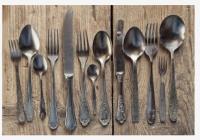 Add My Company
Add My Company
Sign In
Knives and Forks – the Untold Story!
03-02-2017

By Duncan Ellis | 30th August, 2016
It’s an unusual quirk of the language that we can take one word as a description and all of a sudden it’s taken on an entirely new meaning. Google for instance, was originally a noun but suddenly became a verb – as in “Let me Google that for you”.
Another example is the way that we still use the term ‘silverware’ to mean cutlery, when in fact most modern cutlery is made from good old stainless steel. It’s just one of those words that seems to hang on, long after the rest of the world has moved on.
Silverware, as we’ll see later, was actually an accurate word at one point, but the earliest forks were made from a variety of materials and weren’t used for eating with, but as a serving implement. The history of them is a little foggy, but the name ‘fork’ comes from ‘furca’, which we would know as a pitchfork. Table forks appear to begin in the first millennium AD and came from the Byzantine Empire; the wife of Otto II used one at a banquet and astounded the Western hosts!
The use of the fork as cutlery then spread through Italy and to northern Europe and into Britain over the next few hundred years. By the 16th Century, Sheffield was a city famous for the manufacture of cutlery. The problem was that these small implements were made from ordinary carbon steel, which reacted to oxygen rich or damp environments and began to oxidise or rust. Unless the forks were frequently polished, they began to rust which caused problems with both hygiene and tainting the food.
For more information on Knives and Forks – the Untold Story! talk to West Yorkshire Steel Co Ltd
Enquire Now
List your company on FindTheNeedle.

